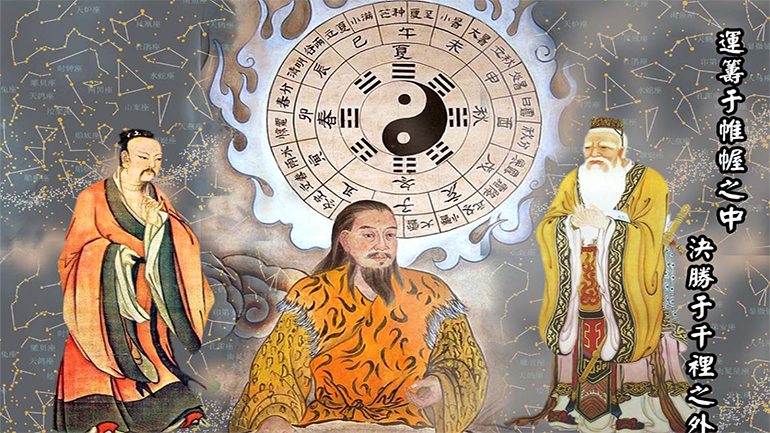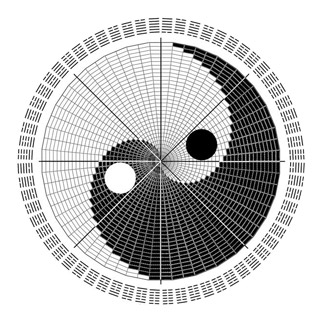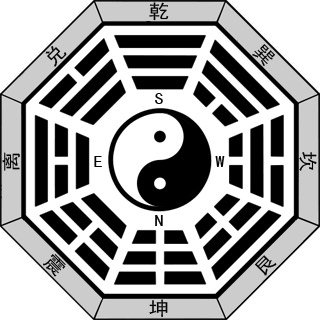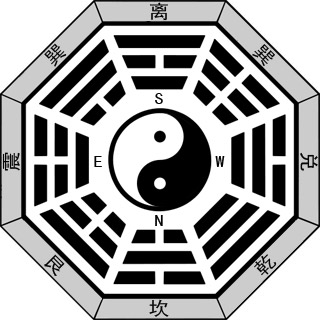
I Ching, also Yi Jing or The Book of Changes, is thought to be the oldest and most abstruse classic in Chinese history. Reputedly, it originated with Fu Xi, who is a mythical sovereign being the first of the three primogenitors of Chinese civilization. It is also called Zhou Yi reputedly because it is not until the Western Zhou Dynasty that the whole context of I Ching was understood. The first king of Zhou, King Wen, concentrated on the study the mystery of changes when he was put in prison for seven years. It has been an aid to foretell the future and make decisions for thousands of years. However, it means more than a book of divination.

Tai Chi Symbol Represents Yi Yang
In Chinese, Yi means change, an eternal truth to descript the world's motion. Jing means the way or classic. So, I Ching is a classic text to expatriate inexhaustible changes. Rich philosophic viewpoints lurked in the thoughts have provided a case of guiding significance. It is a well built philosophic ideology, which is for most of the people obscure and difficult to follow. Hence there are a lot of eisegesis. After King Wen's composition and commentary, I Ching was expanded from the range of divination to science. It is said that the earliest extant I Ching was written on bamboo slips during the Warring States Period. In the Han Dynasty, I Ching inspired the Taoism to create many theories of regimen which were derived from Yi Yang, The Five Elements, Ba Gua. It was first introduced to the western world by missionary in late Ming Dynasty and explained by Germany mathematician with binary code. I Ching affected Confucianism very much and it was the foundation of Taoism. It survived the 'Burning of the books and Burying of the Scholars' Qin Shi Huang committed. Then, it could continue functioning to have impact on Tai Chi Quan (Shadowboxing), Feng Shui in architecture, Chinese Go game and many aspects in Chinese cultural.
Yin Yang
Yi Yang is a materialistic concept of Taoism which dialectically describes every thing in the world has contrary sides and these contrary forces are interconnected and interdependent in the natural world. For example, the south of a mountain refers to Yang, similarly the north of a river, upper side of a leave, man and the sun, and conversely Yin refers to the north of a mountain, south of a river, reverse side of a leave, women and the Moon. Seen from the Tai Chi symbol, when the yang energy is at the peak time, the yin energy has gradually shown up. This is a profound philosophy saying that things at the worse will mend. Many branches of traditional Chinese medicine and philosophy adopted the Yin Yang theory as their primary guidelines.
Here is the description in I-Ching about how world began:
The infinite produces limit and this is the supreme ultimate (Tai Chi or the absolute);
The Tai Chi produces two forms, yin and Yang;
The two forms produce the four phenomena, shao yin, tai yin (the Moon), shao yang, tai yang (the Sun);
The four phenomena act on the eight trigrams (ba gua): sky, earth, mountain, water, wind, hire, thunder and lake/marsh.
There is another description: when the world began, there are heaven (sky) and earth. They mated to give birth to every thing in the world. Heaven is called the Qian trigram (Qian Gua) and the earth is Kun trigram (Kun Gua). The remain trigrams are Dui, Li, Zhen, Xun, Kan, Gen respectively representing lake, hire, thunder, wind, water and mountain.
Yin Yang and Chinese Medicine
Body visceral organs, channels and collaterals all have yin and yang sides. The upper part of the body is assigned to Yang, while the lower part to Yin. Health is based on the balance of yin and yang. Yang vacuity will represent heat sensations, dry mouth, night sweats, dark urine, etc, while the yang vacuity will represent cold limbs, slow pulse, bright white complexion, etc.
Ba Gua (Eight Trigrams)
Ba Gua is a set of symbolic signs. — represents Yang and –– represents Yin. Each of the eight trigrams consists of three signs, having the special meaning. The combination of the eight trigrams produces 64 trigrams which symbolize all the things and phenomenon in the nature and life. In Chinese traditional medicine, Ba Gua refers to the eight acupuncture points around the hollow of hands. It also refers to the gossip in the world of entertainment.

Fu Xi Ba Gua

King Wen Ba Gua
Chinese character 'Gua' is comprised of two parts, left part meaning a mud pillar used to observe the shadow of the sun, and right part meaning measurement. Ba Gua means to observe the sun shadow from every quarter in order to know the seasons and guide the agricultural production. In I Ching, the meaning of gua was extended to be the phenomenon in the universe. There are two arrangements of Ba Gua Hexagram, Early Heaven or Fuxi Ba Gua, and Later Heaven or King Wen Ba Gua. Fuxin Ba Gua was also created by Fu Xi, at the same time with I Ching. King Wen Ba Gua was arranged by King Wen who toppled the Shang Dynasty. Qian Gua is the first trigram in Fuxi Ba Gua and Dui replaced in King Wen Ba Gua. The other seven Guas changed their places accordingly.
Symbols of the Eight Trigrams (Each trigram has more symbols than those listed below)

Each diagram corresponds to an aspect of life and cardinal direction. Therefore, the Ba Gua Hexagram is also a tool in Feng Shui used to map a room or location. The explanation on each trigram is complicated. It is undoubted the classic of ancient cosmic principles. I Ching, to be precise Ba Gua as a divination text has been long since regarded to serve the illiterate or superstitious person but conceded to be vain by scholars and elite.



 闽公网安备 35020302035673号
闽公网安备 35020302035673号
0 responses on "The Book of Changes"